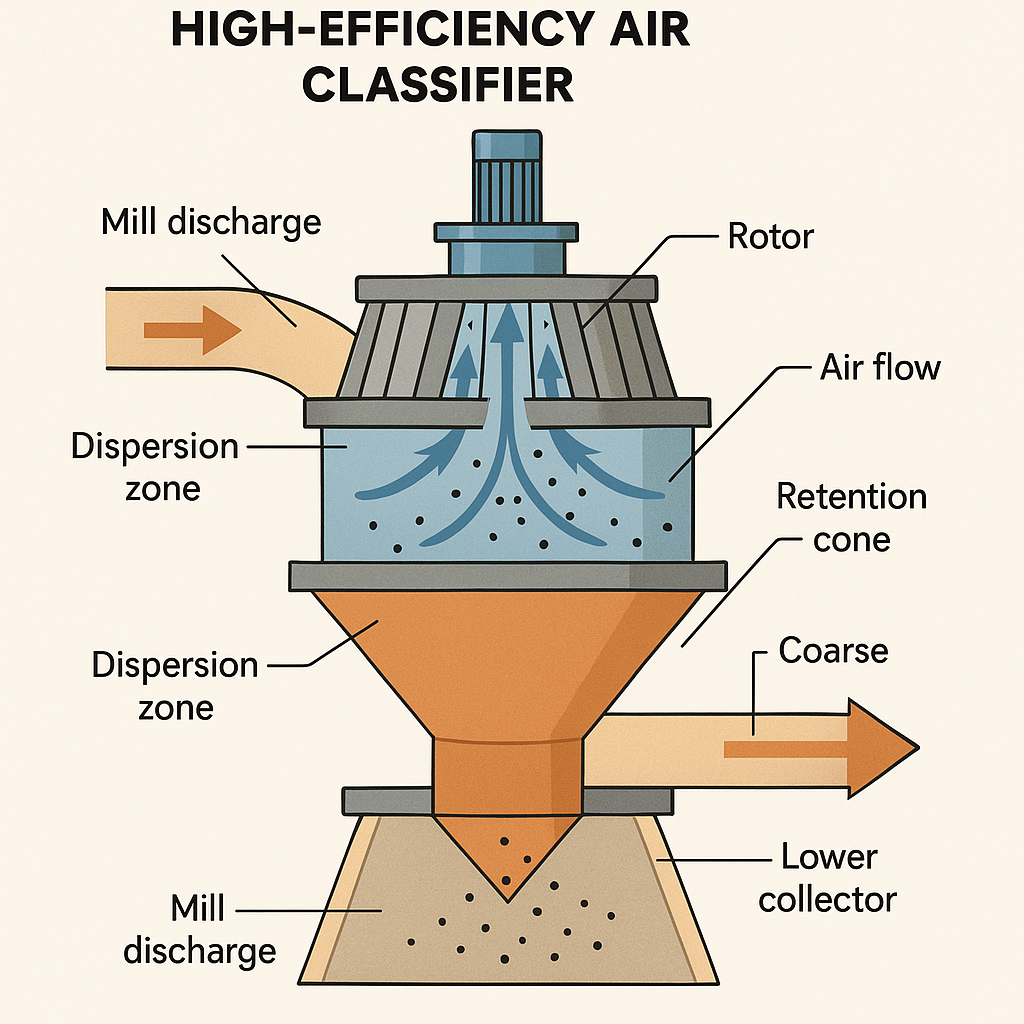Inside the Spin: How High‑Efficiency Separators Are Rewriting Raw Milling
Modern, high‑efficiency air classifiers sharpen the cut in raw milling, send fines out, and push coarse back to the grind — boosting capacity, trimming power, and tightening raw meal quality.
Industry: Cement | Process: Raw_Milling_&_Blending
In today’s closed‑circuit raw mills, the heavy lifting is happening in a fast‑spinning cage you never see. Mill discharge hits a turbulent dispersion zone and a high‑speed air stream decides what leaves as product and what goes back for another grind. That simple split — fines out, coarse back — now hinges on high‑efficiency separators with much sharper control than older designs.
Third‑generation (“dynamic”) separators are explicitly engineered to keep coarse particles “in the separation zone as long as possible” for complete deagglomeration, according to World Cement. In one modern layout, Intercem uses guide vanes and a retention cone so oversize grit is flung outward and discharged through a lower collector, whereas only fines exit as product (World Cement).
Air classification and cut control
An air classifier (separator) is a flow‑sorting device: mill discharge enters between a stationary table and a spinning rotor cage, where airflow carries fine particles upward into the product stream while heavier coarse particles fail to stay entrained and fall back to the mill for further grinding. The separator’s “cut size” (the size threshold that splits fines from coarse) is largely set by rotor speed and air flow; higher rotor speed and flow increase lift for finer cuts (World Cement; Azra Media Indonesia).
Plant‑level nuances matter. In one Indonesian cement plant, a vertical raw‑mill classifier “impedes the airflow – at higher separator speeds the lift on particles becomes low,” enabling precise control of the product fineness (Azra Media Indonesia).
High‑efficiency separator models
“High‑efficiency” separators deliver a sharper cut and higher fines yield than older units. FLSmidth’s O‑Sepa separator — with over 425 units installed worldwide — is promoted as achieving improved separation efficiency, meaning far fewer product‑sized fines are returned to the mill (FLSmidth). FLSmidth states this “offers improved separation efficiency. This means less fine material is returned to the mill,” which in turn “reduces mill power consumption at a given product fineness” and “maximizes system capacity” (FLSmidth).
The improved cut tightens the particle‑size distribution (PSD, the spread of particle sizes), with a “better product size distribution” and more uniform fineness that allow higher throughput (FLSmidth). Meanwhile, Hefei CRDI’s HFX separator is claimed to raise separation efficiency by over 10 percentage points versus conventional units, shifting material into the 3–30 μm (micrometer) range while noticeably cutting the coarse (~200 μm) fraction of the raw meal (Hefei CRDI).
Capacity and energy impact
Optimizing the separator pays off in mill capacity and energy. With fewer fines cycling back (lower “circulating load,” i.e., material returning to the mill), the mill grinds more net product per unit energy. FLSmidth underscores that improved classification “reduces mill power consumption” while “maximizing system capacity” (FLSmidth), and reports over 425 O‑Sepa separators sold globally — as of 2025 — thanks to energy‑savings and capacity advantages (FLSmidth).
In practice this can mean double‑digit throughput gains. Converting a traditional classifier to a modern high‑efficiency unit often boosts production by roughly 5–15% at the same specific grinding energy, while reduced recirculation lowers fan and motor loads. Even at high finenesses, dynamic classifiers now handle large throughputs; a recent plant spec calls for an ICS‑143 classifier at ~115 t/h (tonnes per hour) for 3000 cm²/g Blaine feed (Blaine is a measure of fineness) (Global Cement).
Raw meal quality and kiln stability

Sharper classification directly improves grind quality. Reducing the coarse tail of the PSD accelerates kiln reactions and homogenizes the feed. Hefei CRDI reports that a high‑efficiency separator “reduces the 200 μm sieve of raw meal to increase burnability” (Hefei CRDI).
Industry experts note that smaller particles heat and react faster, allowing CaO and other components to diffuse fully into clinker minerals (for example, C₃S) within the available residence time, reducing unreacted lumps (CemNet forum). A well‑controlled separator also stabilizes grade: raw meal quality metrics often target very low variability — for example, a coefficient of variation ≤5% on the R₉₀μm fineness (R₉₀μm is the percent retained on a 90 μm sieve) is a typical goal (Cement Equipment). A stable, high‑efficiency classifier output — with its repeatable cut‑point — helps achieve that uniformity, yielding raw meal that is both more burnable and more consistent, ultimately improving clinker quality and kiln stability.
Sources: Technical descriptions of cement grinding separators (World Cement; FLSmidth; Azra Media Indonesia); industry case data on separator performance (FLSmidth; Hefei CRDI; CemNet); raw meal specification guidelines (Cement Equipment).
